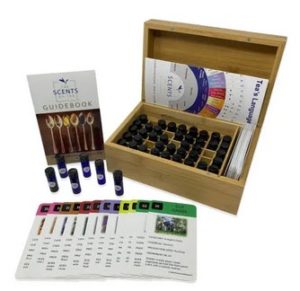
This is an unusual Tea Journey review: a kit of 45 vials of chemical compounds that correspond directly with the primary scents of tea.
The Tea Aroma Kit: Mastering Tea’s Language of Smell is an experiential tool supported by a short guidebook and a mapping of the scents in relation to how they are formed in the stages of tea processing – shown schematically as a fan – plus the types of tea in which they are dominant: cut grass, crushed leaf and drying leaf for greens, pale flowers in oolongs and white roasted scents in blacks.
Tea Journey reviews are not sponsored or financially supported. Tea Journey paid for the kit. I was asked by our editor to try it and give my opinion. Our reason for singling it out is that it has been a striking and effective part of education sessions at the World Tea Expo and seemed to offer something of genuine value to the Tea Journey community.
Related: The Science Behind the Scents of Tea
The Tea Aroma Kit does just that. It’s an impressive resource that fills a wide gap in tea information and education: the lack of a language and shared frameworks for communicating one of the key elements of the tea experience: its aromas. The kit provides these through four main design features:
Short Guidebook: provides the organizing orientation and explanation. It focuses on how the scents are generated by the leaf in response to the damage to its structures that begin with the plucking from the bush.
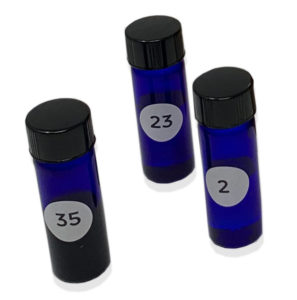
Scent Kit: 45 small vials that contain the individual chemicals that produce the primary scents of tea. This is the core of helping you relate science to the sensory experience of tea drinking. The 45 scents cover the main ones in tea. Each vial is well-sealed, and it’s easy to shake them and twist off and smell the cap. The selection is mainly the work of Dr. Virginia Utermohlen Lovelace, who has a very distinguished academic record as a professor of nutritional sciences at Cornell University, partnering with Scott Svihula, a tea, and coffee specialist and professional taster. He has played a major role in influential educational forums, including the World Tea Academy and World Tea Expo. The kit is scientifically well-grounded, educationally well-structured, and commercially well-designed.
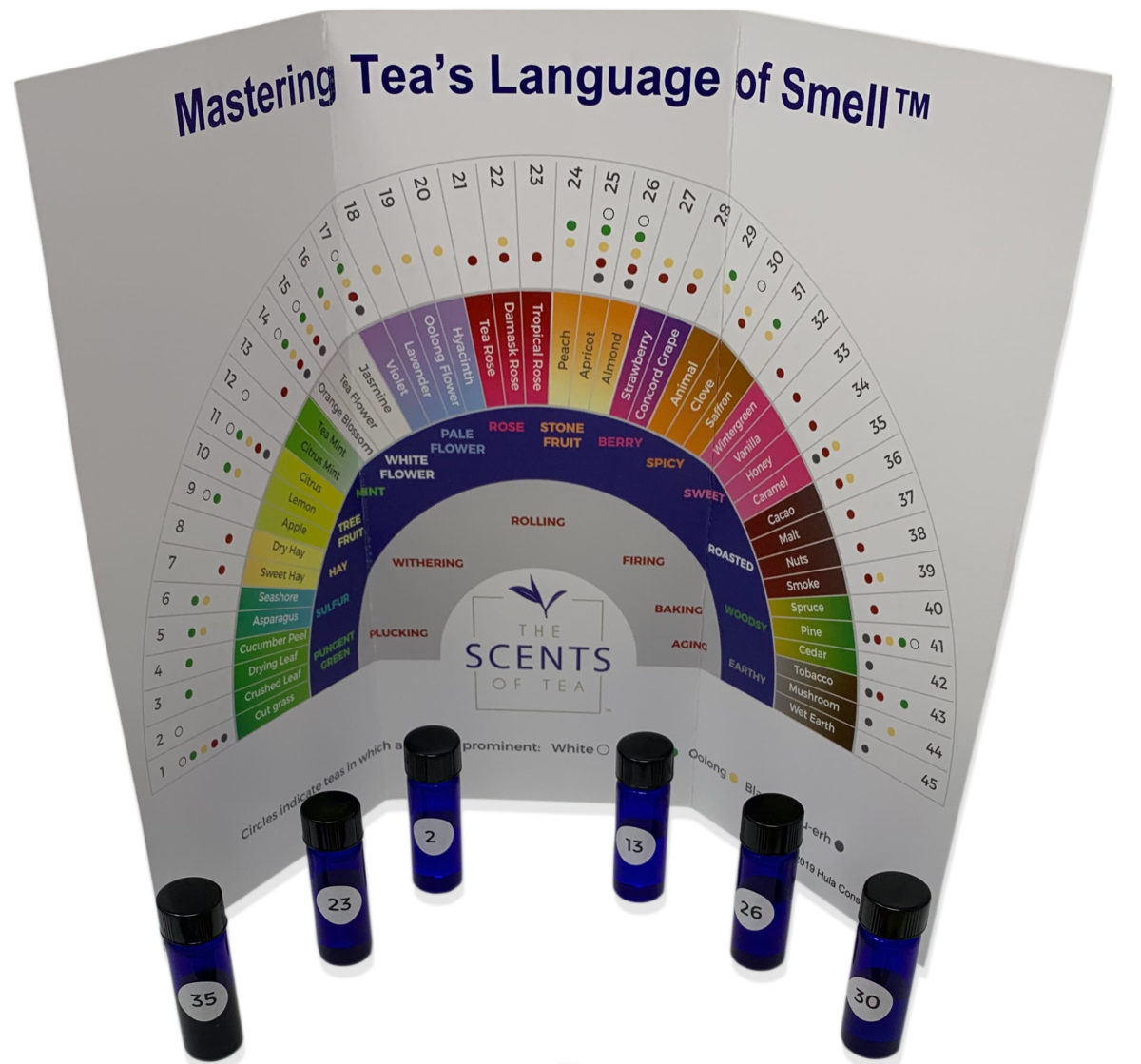
Scent Fan: A page-size fold-out cardboard sheet that organizes scents under categories like fruity, earthy, and vegetal. Earthy breaks down into marine, mineral, earth, and wood. The outer rim of the wheel lists the individual scents. Earthy/Mineral is comprised of just a few: wet rocks, metallic, and salt. The Tea Scent Fan classifies the groups within the tea processing sequence, a more useful and meaningful conceptualization than the many tea flavor wheels that may show a hundred tastes with no clear logical base. The core of Tea Aroma Kit is to explain scents in terms of how they are formed, not just what they are.
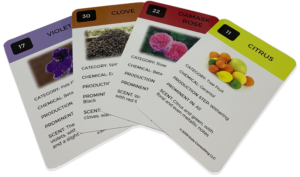
Flashcards: One per scent, these are tools for basic note-taking as you, say, try to recognize an aroma – memory recall from experience has consistently been found to improve this skill – or check it out in the teas you try, or even use the cards for a game. Each card is an aide-memoire showing the Type and Category: Hay, sweet hay (versus dry), for instance, its chemical: Coumarin, Processing step where it is formed: Withering, Tea type where it is dominant: Black, Scent description: Sweet, warm, somewhat spicy odor, like new-mown hay.
This all provides a clear framework for understanding and recognizing scents: the organizing focus is on the chemistry of tea in the sequence of its processing: from plucking to finishing. This simply but not simplistically describes how the scent components are built. The 95-page very small-format guidebook is a model of exposition. It decluttered a subject where, like many non-experts but reasonably knowledgeable tea lovers, I have a jumble of understanding.
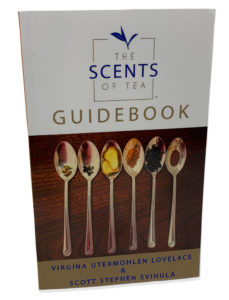
The Guidebook lays out a science storyline that the kit and fan help you explore and apply, and the Flashcards reinforce:
- How tea leaves produce scent: tea structure and cells.
- Tea scent and terroir: climate, latitude, shade, insect damage.
- How teas are made: plucking, withering, rolling, firing and baking, rolling after firing, fermenting (pu-ers).
- Identification of scents: scientific base, how our nose experiences odors.
- The scents from each of the stages from plucking through to aging.
The importance of scents to the tea experience is multidimensional and fundamental. Try chewing on a piece of fine Belgium chocolate; the taste is so evocative, rich and satisfying. Now, try another piece, holding your nose to block off your olfactory receptors. The chocolate is now tasteless.
You have about 350 odors programmed in the genes that enable you to recognize 10,000 different smells. But, typically, you will be able to describe a small fraction of these. You won’t be able to discriminate, without the training that this kit helps shape, the varieties of carotenoids, formed as the tea cells break down and that give it so many exquisite floral flavors. You won’t know what to look for in the range of oolongs whose degree of oxidation and baking, roasting and drying bring out aroma-rich compounds.
Related: Tea Aroma: The Intimate Journey
My reaction to Tea Aroma Kit as an intellectual and experiential innovation is very positive. I don’t know of anything that matches it in content and format. After getting familiar with it, I checked Dr. Lovelace’s short book Three Basic Teas and How to Enjoy Them. It’s an A+. Crisply written and very clear in its presentation. I recommend it for its own merits and suggest it is an excellent addition and complement to the kit.
The physical product is well-made and functional: a robust and spacious bamboo box, quality vials, and solid printing materials. The price is high in terms of dollars out. The issue, of course, is value in. For a specialty tea seller aiming to interest and educate customers, it’s high value/low cost. For tea lovers ready to spend hundreds or more for top-of-the-line Darjeeling, Mao Fengs and puer, it’s well worth considering. For non-professional devotees like myself, it’s certainly not a waste of money. It is priced around the cost of a quality tea brewer. For those who aren’t quite sure whether this is a luxury or necessity, there’s always “Dear Santa…” appeals.
I end with a smile. I like this product very much and admire the expertise of its creators.
Tea Market
Get More Value from Your Tea: BRU Maker One
+41794574278
Jacque's Organics
(647) 804-7263